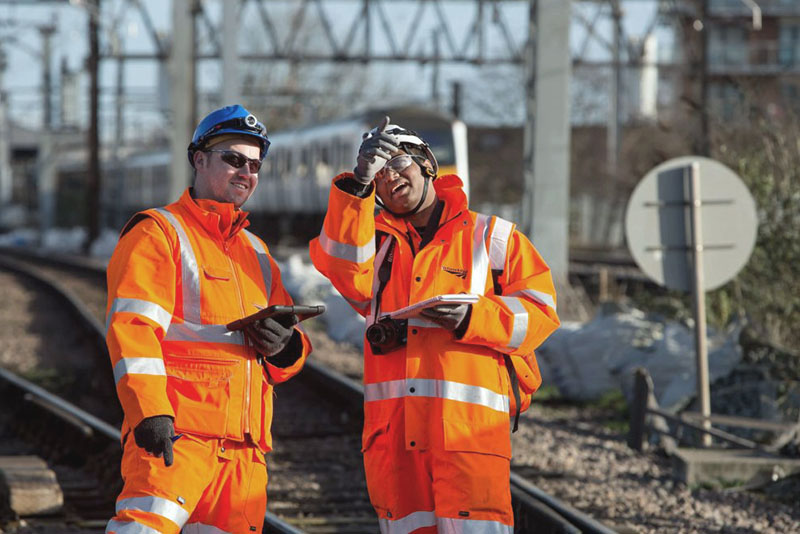Absent reporting is one of the biggest causes of fines and NCRs, not to mention accidents, in the workplace. In this article, we explore how to encourage better reporting practices to improve safety on the frontline.
Whether it’s identifying a potential hazard, flagging up unsafe working conditions, or documenting on-site accidents and near misses; health and safety reporting plays a pivotal role in preventing costly, damaging, and sometimes fatal consequences for businesses and their employees.
Nowhere is the need for accurate health and safety reporting more pronounced than in physical industries such as rail and construction. The predominantly manual nature of these sectors brings with them numerous risks, with on-site employees often required to handle heavy loads, work at a height, and operate large machinery.
These risks are backed up by statistics from the Health & Safety Executive (HSE) who found that the construction industry is not only responsible for a third of fatal injuries that happen in the workplace, but also 10% of other major work-related injuries. Injuries and fatalities typically occur as a result of workers falling from a height, being struck by moving objects such as an oncoming train, or being crushed by vehicles or machinery.
With so many potential pitfalls, it’s more important than ever that your frontline staff understand the value of prompt, efficient incident reporting. Having a workforce that is fully committed to health and safety protocol not only gives peace of mind in the present but is also key to preventing any unwanted accidents in the future.
While it’s natural for employees in any workplace to show apprehension when faced with potential change, just a small amount of forward planning can go a long way to ensuring that your staff are fully committed to the new best practices.
Here are 6 proven ways to promote the benefits of safety reporting to your staff and encourage process adoption:
1. Communicate at all stages
There’s nothing more detrimental to employee buy-in than poor communication. It’s therefore crucial that workers are informed of the pending changes to health and safety protocol in a clear and concise manner that sets expectations from the get-go.
The main purpose of a communication plan is to provide senior figures like stakeholders, executives, and department managers with a timeline for implementation, so they’re fully aware of the progress, milestones, and any actions required along the way.
If executed well, the communication plan will provide all department owners and managers with the tools they need to support their respective teams throughout the change, easing the burden and reducing the possibility of confusion or misinformation by providing clarity across the board.
2. Organise reporting workshops
While absent reporting creates obvious problems, poorly recorded incident reports can be equally detrimental to workplace safety. Without the presence of a clear, established template for incident documentation, many health and safety reports fail to provide the sufficient information required to prevent future on-site hazards.
As with any new process, an effective training program will be invaluable to ensuring employees are equipped with the required information to carry out the new best practices to improve incident reporting. Organising reporting workshops will allow users to gain practical experience of the new incident reporting process before it goes live. This will not only create confidence across the workforce, but it will allow management to identify any potential user mistakes and application issues before they become a serious problem.
With such a significant variation in age, role, and technological experience within the construction and rail industries, a one-size-fits-all approach to training is simply not realistic and can alienate certain members of the team. It’s therefore important that training is modified to suit the individual’s need, with refresher sessions offered where appropriate.

Construction giant Murphy recently deployed 3 mobile apps to replace their paper frontline reporting process.
Find out how they did it
3. Use regular spot checks on site
In order for your new protocol to be successful, it’s essential that on-site workers adopt health and safety diligence as part of their daily routine. Implementing regular spot checks encourages workers to adopt a consistent approach to their safety reporting and helps ensure that best practices are followed at all times.
As well as encouraging adherence to the processes, spot checks can help create a safer working environment in numerous other ways; from identifying unsafe areas on-site to correcting any mistakes or misunderstandings in relation to the health and safety requirements.
From an end-user perspective, these checks provide the opportunity to address any personal concerns they may have regarding site safety and allows them to suggest ways to improve accident reporting processes.
4. Ensure data entry is standardised
Bad or inaccurate data often leads to problems in the administration stage, which results in this data either not being processed or skewing facts and figures. It’s therefore imperative that any health and safety reporting is recorded in a uniform template, greatly reducing the capacity for errors in data processing.
Despite the obvious benefits of a clear reporting structure, many companies will unfortunately still find themselves bound by the limitations that affect all paper-based processes. With everything from incomplete forms to lost and misplaced admin sure to have a detrimental impact on data quality, the nature of paper-based reporting means there will always be some discrepancies that cannot be accounted for.
Standardising data entry can be really challenging, because you really can’t control what a site worker writes when pen hits paper, you can only advise on best practices with training, demos and workshops. The only real solution is to replace your paper processes with a digital reporting tool that restricts the format, length, and type of data that can be entered using field validation rules. This means reports physically can’t be submitted until data is entered in a standardised format.
5. Enable your team with the right tools
Even when the process goes smoothly, the inevitable communication lag created by paper-based solutions can compromise the effectiveness of incident reporting. This is particularly problematic in the rail and construction industries, where a prompt reaction to danger can genuinely be the difference between life and death.
Instant reporting
It’s because of these issues that many companies have begun to digitise their health and safety processes. A frontline reporting solution makes it possible to inform both on-site and back-office staff of any potential hazards or incidents immediately, allowing them to remain up to date with developments on the go and deal with on-site dangers in a timely manner.
The ease of the digital reporting process allows end-users to engage in health and safety protocol without facing the burden of extensive admin.
Data validation
A digital solution can also reduce the risk of poorly recorded data. Whereas print forms can be sent off with unfilled boxes and incomplete sections, a health and safety app ensures the form cannot be submitted until all required sections are completed with the right kind of data, ensuring quality reporting and increasing the likelihood of a safer working environment. This naturally improves accountability, with an in-built audit trail clearly identifying the worker who submitted a specific entry, where, and when.
Data storage, exports and integration
Saving information in the cloud also provides greater security than paper-based reporting, and makes it easier to get this data where you want it to be. An app solution allows you to export data in a digital format, or even integrate with your existing databases to make interpreting this information even easier.
Nutshell Apps has a library of industry-standard health and safety apps that can be customised freely to fit your processes. Many businesses across the rail and construction industries require subtle variations to their forms and processes, and Nutshell ensures your apps can be tailored to suit the needs of your very specific company.
As well as instant frontline reporting, data validation, and the ability to export data either in a digital or hard copy or integrated with your back-office system, Nutshell also has an offline mode, which can be a vital feature when faced with the notoriously poor internet often found on rail and construction sites. This feature eliminates the threat of lost data and ensures that reports can be logged promptly as soon as the user regains internet access.
6. Report back to the team
Informing employees of report findings plays a key role in entrenching the importance of health and safety protocol and maintaining process adoption. By sharing the results of reports, you demonstrate to employees that they’re contributing to a safer working environment while identifying any potential hazards and accidents that have been prevented by effective reporting.
Making this data accessible can also highlight any incidents where substandard reporting has increased risk in the workplace. The availability of this information will provide employees with genuine evidence supporting the value of adhering to health and safety best practices.
Reporting back to the workforce keeps the health and safety requirements fresh in their mind, allowing for any knowledge gaps to be managed and concerns with the current processes to be addressed.
Good-quality reporting remains an integral part of ensuring safety in high-risk working environments. Thankfully, technological advancements have eradicated many of the problems that previously made health and safety management such a painstaking process.

All your Health and Safety forms, reports, inspections and compliance checklists, in a nutshell…
Learn how Nutshell Apps streamlines reporting and administration to reduce your risk of fines and NCRs

